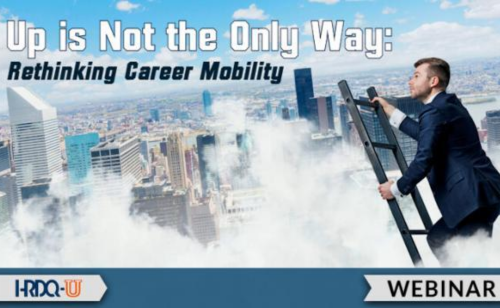When it comes to talent development, leaders and managers often find themselves juggling numerous priorities and responsibilities. In the quest to balance mission-critical tasks and long-term goals, the concept of talent development strategies and implementation can easily get lost amidst the chaos. However, this blog challenges the conventional approach to talent development and proposes a transformative perspective. Instead of treating talent development as an isolated activity, it advocates for infusing it into every aspect of a leader’s role. From embracing development through dialogue to fostering transparency and leveraging a learning lens, this blog explores practical strategies for busy leaders to nurture talent and drive organizational growth.
Join Dr. Kaye’s Webinar and learn more about career mobility
Up is Not the Only Way: Rethinking Career Mobility
Where do I start with talent development?
Over the course of a career, talent managers may have attended a time-management or priority-setting workshop during which an instructor piles rocks into a vessel and asks participants the typical trick question: Is it full? Then pebbles are poured in, filling the space between the bigger rocks, and the question is repeated. Finally, sand is added to occupy the small spaces among the pebbles, making the point that setting the big priorities first allows one to accomplish many other smaller ones then. The same idea must apply to talent development, right?
Wrong.
Today’s managers and leaders operate in a pressure-cooker environment, rich with priorities, activities, and expectations but impoverished in time and resources. Their plates are piled high with mission-critical tasks — or the rocks — and short- and long-term goals — the pebbles. The space remaining is occupied with other responsibilities as assigned — the sand. Sprinkle anything more atop this overflowing plate; you’ll likely see it fall right off. Or worse, it may shift the delicate balance that’s been struck, causing the larger and more significant things to go tumbling. So, how are busy leaders expected to add talent development — or anything, for that matter — to these already full plates? The truth is they can’t. And that is a very good thing for talent development. The frenetic and full environment that is today’s workplace offers an opportunity to reconceive and rebrand talent development completely. No longer must it be limited to a task or activity. Instead, talent development can now be something much broader and more pervasive.
For talent development to thrive, it cannot exist as even an extra grain of salt sprinkled atop the overflowing plates of overwhelming responsibilities. It must instead become a spirit that is brought to every activity that leaders engage in, an intention that’s infused into every interaction, or the objective that envelops every relationship. In essence, talent development must cease to exist as a separate and distinct activity and become a driving force that pervades everything else leaders do. It also must be baked right into the routine work rather than layered on top. And as lofty and grand as this goal may sound, the way to make it happen is simple.
Effective leaders who have discovered the power of this more ephemeral approach come to talent development strategies with a different mindset — one that’s based upon the belief that dialogue offers a powerful springboard for development, that transparency can drive tremendous learning, and that learning is everywhere.
Three talent development strategies to implement
1. Development via dialogue
One of the most pervasive features of today’s business landscape is conversation. Through conversation, deals are made, innovations are identified, savings are found, and development happens. Effective leaders allow development to find a home in all of the dialogues in which they engage. They understand the power of these small moments with others and leverage each to its fullest extent, taking advantage of seemingly insignificant moments and infusing them with the opportunity for greater awareness, reflection, insight, and potential action.
Examples include:
• A passing comment about a tough customer is a chance to talk briefly about how the customer base is changing, what customers expect today, how that may change in the future, and the implications for the organization and individual. (we recommend webinar customer service).
• A project review is an opportunity to explore strengths, skills, and opportunities for growth.
• A mistake is the perfect excuse to talk about lessons learned, how they can be applied in different contexts to different challenges, and alternate approaches to enhance future success.
Rethinking dialogue and seeing it as a vehicle for talent development allows busy managers to redeploy the time they are already spending in conversation, inspire insights that can spark change, and demonstrate the possibilities for learning every moment of every day.
2. Transparency equals teaching
Today’s workers are more educated and resourceful than at any time in history. Many can connect the dots for themselves, in turn translating events, occurrences, and information into valuable learning. All they need is visibility to these things to make that happen. Too frequently, managers see their role as a filter, screen, or buffer between reality and their employees. In a well-intentioned effort to help their busy staffs manage their own overflowing plates, leaders may block out or hoard information that could contribute to talent development.
Imagine what smart workers could accomplish with regular access to:
• Information about how the business is really performing.
• The specific rationale for why someone is being promoted or recognized.
• Candid reasons for organizational changes.
• What’s next on the horizon.
It likely takes leaders more time to figure out how to redact, sanitize, edit, spin, and repackage these messages for their employees. Eliminating this step not only enhances transparency but it may also remove a stone or pebble for busy managers themselves.
But transparency can play out in another way for astute, development-oriented leaders. In years gone by, a manager was tasked with leading the performance of his or her team or department and nothing more. Today, most managers are “working” managers, meaning they are responsible for turning out deliverables of their own in addition to supervising others. This also adds to the overflowing nature of their plates. The working part of the manager’s role offers another chance for transparency. Rather than performing their tasks undercover, leaders may want to make the work they do more overt. Those around them can pick up cues and skills when leaders share what they do and why. Allowing others to shadow or ride along, narrate a task, offer insights into the rationale for certain steps, and share missteps and mistakes related to one’s own work can be a powerful model and learning tool. Yet, this sort of transparency doesn’t add anything to a manager’s workload. It simply recasts the tasks and responsibilities that already exist and extends them beyond individual output by creating fodder for powerful employee-led learning.
3. Leverage a learning lens
One final time-neutral strategy for busy managers who want to enable the development of others involves adopting a new view of work. These leaders naturally help others grow by instilling the discipline associated with milking each experience for every drop of development available. They know that successes, struggles, and seemingly insignificant moments in the day can activate learning by just drawing it out with a few quick questions.
These questions include:
• What did you learn from that?
• What does that mean to you?
• What will you do in the future as a result?
Talent development as a tool for success
By looking through the learning lens, a leader models and helps others develop the ability to transform experiences into insights and use life as a learning lab. And looking through this lens doesn’t involve an additional “to-do” or meeting on the calendar. It’s simply a different way of operating and making the most of each interaction and event encountered. In the end, doable and durable talent development — the kind able to withstand the wear and pressure of today’s workforce demands — cannot be considered an “activity.” It’s a mindset that permeates a manager’s approach to work. It’s a spirit that pervades the countless events and tasks a leader engages in every day. It’s an intention that’s brought to every interaction. And it’s the way even the busiest managers can make their most profound contribution to the organization — by developing talent.
Recommended Webinar
Learn how to navigate through a rich mix of experiences, roles, and opportunities, allowing you to adapt and thrive in a changing world of work.
Join our webinar to discover how embracing career mobility is essential for success in today’s marketplace.
About the Authors
By Julie Winkle Giulioni and Beverly Kaye
Julie Winkle Giulioni ⇗ has championed workplace growth and development. She operates on the belief that everyone deserves the opportunity to reach their potential. And she works with organizations and leaders who want to make that happen. Julie is the co-author of the international bestseller, Help Them Grow or Watch Them Go: Career Conversations Organizations Need, and Employees Want, translated into seven languages, and Promotions Are So Yesterday: Redefine Career Development. Help Employees Thrive. In addition to writing and speaking on workplace and development issues, Julie Winkle Giulioni leads DesignArounds, a firm that creates and offers training to organizations worldwide.
Dr. Beverly Kaye, Founder of Career Systems International, is recognized internationally as one of the most invested, knowledgeable, and practical professionals in the areas of career development, employee engagement & retention, and mentoring. She was named a “Legend” by ASTD, a designation given to “pioneers and prophets in the field of workplace learning and performance.” The criteria that Legends must meet are enduring impact and influence; originality of ideas; a career of sustained currency; work done more than five years ago is currently discussed, applied, and adapted; a substantive body of published work; and a contribution that raises the visibility, credibility, and stature of the field. She has also been named by Leadership Excellence as one of North America’s 100 top thought leaders.
Beverly has spent years researching corporate strategies for developing, retaining, and engaging knowledge workers. Her book, Love ‘Em or Lose ‘Em: Getting Good People to Stay, co-authored with Sharon Jordan-Evans, has sold over 750,000 copies in 25 languages and has reached Wall Street Journal and Amazon bestseller status. Their companion book, Love It, Don’t Leave It: 26 Ways to Get What You Want at Work, suggests that employee engagement is also the responsibility of the individual contributor. Help Them Grow or Watch Them Go: Career Conversations Employees Want, co-authored with Julie Winkle Giulioni, was published in 2012, and in 2015 she co-authored Hello Stay Interviews, Goodbye Talent Loss: A Manager’s Playbook. Her newest book is titled Up Is Not The Only Way: Rethinking Career Mobility. These books are the foundation for Career Systems International’s successful practice in career development, employee engagement and retention.
Visit their website at www.CareerSystemsIntl.com.
“Related” Learning
Discover more HRDQ-U communication skills blogs and webinars
Access more valuable HRDQ-U content by these authors
Explore HRDQ Store’s communication skills training resources
How did you like this blog on talent development strategies? Comment below!

















